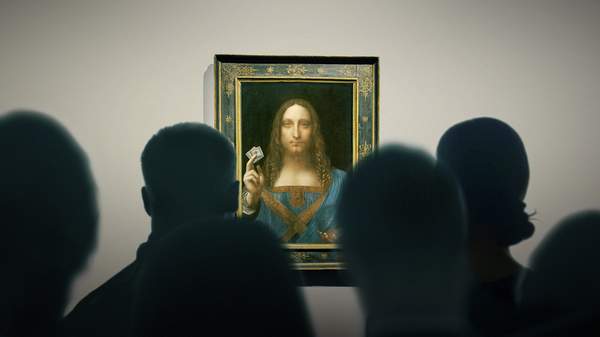Overview
Art of either great or dubious origins. Airport facilities where items can be stored — art masterpieces included — without their owners abiding by taxation rules. Both played parts in Christopher Nolan's Tenet; however, it's no longer the only recent thriller to include the two. The Lost Leonardo doesn't feature a phenomenal heist of a disputed piece from a freeport, but it is as tense and suspenseful as its 2020 predecessor. It also tells a 100-percent true tale about the artwork dubbed the 'male Mona Lisa'. Exploring the story of the Salvator Mundi, a painting of Jesus that may hail from Leonardo da Vinci, this documentary is filled with developments far wilder and stranger than fiction (sorry not sorry Dan Brown). And while there's little that's astonishing about the film's talking heads-meets-recreations approach, it still couldn't be more riveting.
Although the Salvator Mundi itself is thought to date to the 15th century, The Lost Leonardo only jumps back as far as 2005. That's when the High Renaissance-era piece was sold for US$1175, and when Alexander Parrish and Robert Simon, art dealers eager to dig up sleepers — works from renowned masters that've been mislabelled or misattributed — suspected there might be more to it. The pair tasked restorer Dianne Modestini with tending to the heavily overpainted and damaged work, which revealed otherwise unseen details in the process. Cue a now-prevailing theory: that the Salvator Mundi sprung from da Vinci's hands.
That's a shattering revelation given that, despite the prominence that the Mona Lisa and The Last Supper enjoy, the list of surviving works attributed to da Vinci barely hits 20 — and that's with questions lingering over his involvement in quite a few. Uncovering one of his previously unknown paintings was always going to be huge as a result; locating it in such a way, and for so cheap, only bolsters the extraordinary tale. Debates over the painting's provenance have continued for the past 16 years, although that's not the only reason that The Lost Leonardo exists. The piece has increased in fame over the last decade thanks to two factors, including the Salvator Mundi's inclusion in a 2011–12 da Vinci exhibition at the National Gallery, London, placing it alongside the author's accepted works — and its sale for US$75 million in 2013, then for US$127.5 million, and finally again in 2017 for a whopping US$450.3 million.
Its unglamorous discovery, the ongoing argument over authenticity, the legitimacy gained by exhibiting in one of the world's most influential galleries, that it's now the most expensive painting ever sold: these details are unpacked and analysed by writer/director Andreas Koefoed (At Home in the World) via his array of interviewees — and so is the fact that, when that mind-blowing sale occurred, Saudi Arabia's Crown Prince Mohammed bin Salman was the secretive buyer. It's little wonder that the filmmaker has chosen to unfurl the ins and outs of these remarkable events as if he's joining the dots and puzzling together the pieces right in front of viewers' eyes, making The Lost Leonardo a detective story of a doco. It isn't a new approach, let alone a unique or unusual one, but it savvily relies upon the combined force of a ripping yarn and rollicking storytelling.
Within all those twists and turns also sits a vital examination of art, money and power. That works by artists such as da Vinci can end up lost at all is a marker of art's links to wealth and class, and of pieces being controlled by the rich behind closed doors to the detriment of the artistic greater good and public access. The same notions play out in the jaw-dropping Christie's auction, as bids rise to more than double the expected amount (which still would've made it the most expensive painting ever sold) and it becomes evident that the Salvator Mundi won't be purchased by a gallery for public display. The frenzied atmosphere, which the auction house stages like a piece of theatre, is all about control and status. Letting the world see a masterpiece isn't even an afterthought.
An entire documentary could be made about that auction alone, and the techniques deployed to turn it into such a production. Case in point: a Christie's promotion that showed the emotional reactions of art lovers peering at the piece — ordinary folks all visibly moved, and also Leonardo DiCaprio. The reality that art is a business couldn't be painted on a larger canvas. That art is about prestige, too. In getting these points across, Koefoed's choices aren't always subtle — Sveinung Nygaard's (Huss) score would suit a heist film, there's a slow-drip pace to the documentary's early sections to ramp up the intrigue, and sparking a future fictionalised feature based on The Lost Leonardo feels like a clear aim — but everything about the film is always entertaining and effective.
Here's hoping that certain-to-arise dramatisation turns out more like American Animals than The Goldfinch; the former was based on a true story, the latter on a Pulitzer Prize-winner for fiction, but the details here are so juicy, gripping, layered and important that they deserve to be told with the greatest care. As one interviewee puts it, it's the tale of finding a spaceship with unicorns on one's lawn. As the whole cast of talking heads explains — dealers, academics, restorers, art critics and buyers alike, vocal naysayers included — it's the story of commerce usurping creativity and history, regardless of the mystery behind the potential da Vinci work. Perhaps there'll even be a sequel: an NFT of Salvator Mundi now exists, because of course it does.
Features
Information
When
Thursday, December 2, 2021 - Wednesday, December 22, 2021
Thursday, December 2 - Wednesday, December 22, 2021
Where
Select cinemas in MelbourneVarious locations
Price
$15–25-
Event Type
